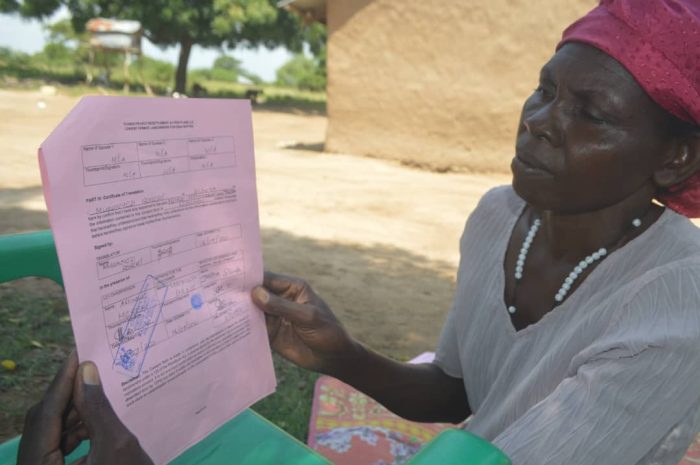
NAPE joins the rest of the world to commemorate International Lead Poisoning Prevention Week of Action (ILPPWA).
This year’s National Lead Poisoning Prevention Week theme is, “Lead-Free Kids for a Healthy Future,” which has focused on the importance of the many ways parents can reduce a child’s exposure to lead and prevent its serious health effects.
National Association of Professional Environmentalists (NAPE) with support from IPEN is creating awareness about the harmful aspects of Lead in selected schools. NAPE is conducting lectures to pupils in primary schools on Lead and Lead poisoning and the major pathways for exposure to lead poisoning including paints, batteries, lead contaminated toys and lead contaminated dust among others.
It has been observed that children under the age of 6 years old are at an increased risk for lead exposure, due to their rapid rate of growth and their tendency to place toys, their fingers and other objects in their mouths that could be containing lead or leaded dust, and thus are more prone to ingestion of lead paint chips and house dust or soil that may contain lead particles.
Lead is a naturally occurring toxic metal found in the Earth’s crust. It is a cumulative toxicant that affects multiple body systems and is particularly harmful to young children. Its widespread use has resulted in extensive environmental contamination, human exposure and significant public health problems in many parts of the world.
Important sources of environmental contamination include mining, smelting, manufacturing and recycling activities, and, in some countries, the continued use of leaded paint and leaded gasoline.
Lead is particularly dangerous because once it gets into a person’s system; it is distributed throughout the body just like helpful minerals such as iron, calcium, and zinc. The body stores lead in the teeth and bones where it accumulates over time.
Lead stored in bone may be remobilized into the blood during pregnancy, thus exposing the fetus. And lead can cause harm wherever it lands in the body. In the bloodstream, for example, it can damage red blood cells and limit their ability to carry oxygen to the organs and tissues that need it, thus causing anemia.
Young children are particularly vulnerable to the toxic effects of lead and can suffer profound and permanent adverse health effects, particularly affecting the development of the brain and nervous system. At high levels of exposure, lead attacks the brain and central nervous system to cause coma, convulsions and even death. Undernourished children are more susceptible to lead because their bodies absorb more lead if other nutrients, such as calcium, are lacking. Children at highest risk are the very young; including the developing fetus, and the impoverished.
Children who survive severe lead poisoning may be left with mental retardation and behavioural disruption. However, at lower levels of exposure it causes no obvious symptoms, and that previously were considered safe, lead is now known to produce a spectrum of injury across multiple body systems.
In particular lead affects children’s brain development resulting in reduced intelligence quotient (IQ), behavioural changes such as shortening of attention span and increased antisocial behaviour, and reduced educational attainment. Lead exposure also causes anaemia, hypertension, renal impairment, immunotoxicity and toxicity to the reproductive organs. The neurological and behavioural effects of lead are believed to be irreversible.
Moreover, children’s innate curiosity and their age-appropriate hand-to-mouth behaviour result in their mouthing and swallowing lead-containing or lead-coated objects, such as contaminated soil or dust and flakes of decaying lead-containing paint. This route of exposure is magnified in children with persistent and compulsive cravings to eat non-food items, who may, for example pick and eat, leaded paint from walls, door frames and furniture. Exposure to lead-contaminated soil and dust resulting from battery recycling may result into massive lead poisoning and multiple deaths in young children.
Lead also causes long-term harm in adults, including increased risk of high blood pressure and kidney damage. Exposure of pregnant women to high levels of lead can cause miscarriage, stillbirth, premature birth and low birth weight, as well as minor malformations.
Lead exposure is estimated to account for 143 000 deaths per year with the highest burden in developing regions. Lead in the body is distributed to the brain, liver, kidney and bones. It is stored in the teeth and bones, where it accumulates over time. Human exposure is usually assessed through the measurement of lead in blood.
There is no known level of lead exposure that is considered safe. Even blood lead concentrations as low as 5 µg/dl, once thought to be a “safe level”, may result in decreased intelligence in children, behavioural difficulties and learning problems. But it is known that, as lead exposure increases, the range and severity of symptoms and effects also increases. However, lead poisoning is entirely preventable.
Drinking water delivered through lead pipes or pipes joined with lead solder may contain lead. Much of the lead in global commerce is now obtained from recycling.
Sources and routes of exposure
People can become exposed to lead through occupational and environmental sources. More than three quarters of global lead consumption is for the manufacture of lead-acid batteries for motor vehicles. Lead is, however, also used in many other products, for example pigments, paints, solder, stained glass, crystal vessels, ammunition, ceramic glazes, jewellery and toys. This mainly results from:
- Inhalation of lead particles generated by burning materials containing lead, e.g. during smelting, informal recycling, stripping leaded paint and using leaded gasoline; and
- Ingestion of lead-contaminated dust, water; from leaded pipes and food; from lead-glazed or lead-soldered containers.
The World Health Organization (WHO) has identified lead as one of ten chemicals of major public health concern, needing action by Member States to protect the health of workers, children and women of reproductive age.






